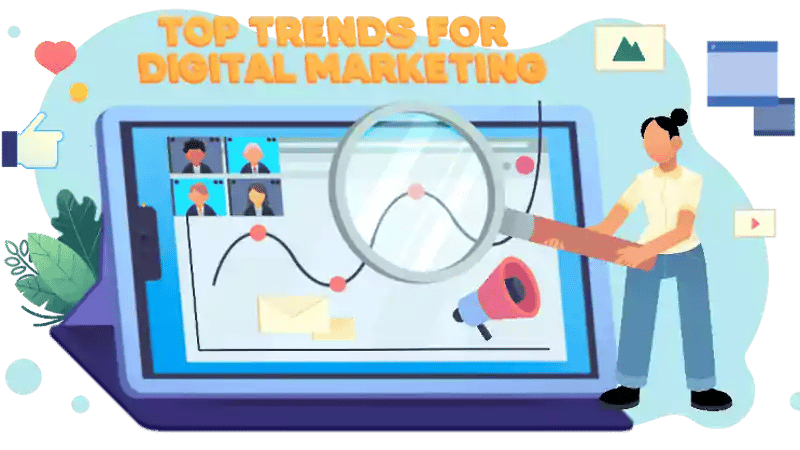Elevate your content with HubSpot Marketing Hub for content marketing. Discover how our strategies and HubSpot's tools drive success.
Top Trends for Digital Marketing: Staying Ahead of the Curve in 2024
In the ever-evolving world of digital marketing, staying ahead of the curve is essential for success. Marketing leaders constantly seek ways to build better customer experience, run effective campaigns, and drive revenue. However, a common challenge lies in navigating the complexities of disconnected tech stacks.
We'll explore the top growth marketing trends shaping the digital landscape this year–and how they can help businesses consolidate their tech stack for maximized success.
Tech Stacks: Broken Down
A tech stack is the collection of software tools, technologies, and frameworks used to build and operate a digital product or application. It encompasses all the components and layers involved in developing, deploying, and maintaining a technology solution. A tech stack typically includes three main layers: the front end, the back end, and the infrastructure layer.
However, when an organization's tech stack becomes fragmented and unconsolidated, it can present several risks and challenges.
-
Data silos
-
Inefficiencies and duplication of efforts
-
Lack of collaboration and cross-functional alignment
On the other hand, when consolidated, a tech stack can offer a multitude of benefits:
-
Unified view of data
-
Streamlined processes
-
Improved data accuracy and integrity
-
Enhanced collaboration and alignment
-
Greater efficiency and productivity
A study by Forrester found that businesses that consolidated their tech stack saved an average of 30% on their IT costs.
Consolidating your tech stack offers advantages–particularly in today's business world, where productivity and digital-savvy mean everything. Let's dive into some of today's top digital marketing trends and how a consolidated tech stack will help you stack up against the competition.
Trend #1: Data-Driven Marketing
Data has emerged as a driving force behind successful marketing strategies in today's fast-paced and competitive digital landscape. Marketers have realized the immense value of data in understanding customer behavior, preferences, and market trends. Data-driven decision-making allows businesses to make informed choices based on evidence rather than guesswork or intuition.
91% of companies say that data-driven decision-making is vital to the growth of their business.
To leverage the power of data, marketers must employ robust analytics tools to collect, analyze, and interpret vast amounts of information. By harnessing the insights derived from data analysis, businesses gain a comprehensive understanding of their target audience, campaign performance, and areas for improvement. With these insights, marketers can make data-driven decisions to refine their messaging, targeting, and overall marketing strategies.
Furthermore, artificial intelligence (AI) and machine learning technologies have revolutionized data-driven decision-making. AI-powered algorithms can analyze complex patterns, identify trends, and automate processes, providing marketers with deeper insights and more accurate predictions. These technologies enable marketers to streamline operations, optimize campaigns, and allocate resources more effectively.
Harnessing the Power of Data with Consolidated Tech Stacks
While data-driven decision-making has become increasingly crucial in modern marketing, its implementation can be challenging without a consolidated tech stack.
Operating with fragmented systems and disconnected tools hinders marketers' ability to obtain a holistic view of their customers and marketing initiatives. Without a consolidated tech stack, data silos emerge, where valuable information is scattered across different platforms and databases. This fragmentation makes it challenging to aggregate and analyze data cohesively, leading to missed opportunities and suboptimal decision-making.
Furthermore, the absence of a unified platform complicates the data analysis and reporting processes as marketers grapple with manual data extraction, transformation, and integration. This consumes valuable time and resources and introduces the risk of errors and inconsistencies, hindering the ability to derive accurate and actionable insights. Maintaining data consistency and accuracy becomes challenging without a consolidated tech stack, as marketers face disparate data sources, formats, and structures.
These inconsistencies in data can lead to unreliable analysis and flawed decision-making, undermining the effectiveness of data-driven marketing strategies. Additionally, managing multiple tools and platforms separately creates inefficiencies and duplication of efforts. Navigating through different interfaces, processes, and reporting mechanisms hampers collaboration and limits the ability to execute cohesive marketing strategies, ultimately impeding cross-functional alignment and gaining a comprehensive understanding of marketing efforts.
However, by embracing a consolidated tech stack like HubSpot Marketing Hub, marketers can overcome these challenges and unlock the true potential of data-driven decision-making. HubSpot provides a centralized platform that seamlessly integrates diverse marketing tools, enabling marketers to consolidate their data, streamline processes, and make informed decisions based on accurate and comprehensive insights.
With a consolidated tech stack, marketers gain a unified view of customers, campaigns, and performance metrics, breaking down data silos and enabling a comprehensive analysis. The platform's robust analytics and reporting capabilities empower marketers to extract actionable insights, track performance, and optimize marketing strategies efficiently.
Furthermore, a consolidated tech stack facilitates streamlined data management, ensuring consistency and accuracy across various data sources. Marketers can automate data processes, reducing manual efforts and minimizing the risk of errors or inconsistencies in data analysis. This centralized approach fosters data integrity and reliability, enhancing the effectiveness of data-driven decision-making.
Trend #2: Personalization and Customer Experience
Personalization and delivering exceptional customer experiences have become paramount in digital marketing. Customers today expect tailored interactions, relevant content, and seamless experiences across various touchpoints. To meet these expectations and stand out, businesses must prioritize personalization and customer experience as key marketing trends.
Without a consolidated tech stack, achieving effective personalization and delivering exceptional customer experiences can be challenging. Marketers often encounter several obstacles that hinder their ability to meet customer expectations:
- Data fragmentation
- Inefficient data analysis
- Inconsistent messaging
- Limited automation
On the other hand, consolidating your tech stack provides significant advantages for implementing effective personalization and delivering exceptional customer experiences:
-
Comprehensive customer data: A consolidated tech stack combines customer data from various sources, enabling a unified view of customer behavior, preferences, and interactions. Marketers can leverage this comprehensive data to personalize messaging, offers, and experiences for individual customers or customer segments.
-
Enhanced data analysis: Marketers can access robust analytics and reporting capabilities with a consolidated tech stack. They can analyze customer data more efficiently, derive meaningful insights, and make data-driven decisions to optimize personalization strategies.
-
Consistent messaging and brand experience: A unified tech stack allows marketers to maintain consistent messaging and brand experiences across multiple channels. This consistency helps create a cohesive and seamless customer journey, fostering stronger connections and brand loyalty.
-
Automation and scalability: A consolidated tech stack often offers automation features, allowing marketers to automate personalized campaigns, messaging, and experiences at scale. This automation enables efficient and timely delivery of personalized content to customers, enhancing their overall experience.
-
Omnichannel integration: Consolidating the tech stack facilitates the integration of various channels and touchpoints, enabling a seamless omnichannel experience. Marketers can deliver personalized messages across different platforms and devices, ensuring a cohesive and tailored customer journey.
By embracing a consolidated tech stack, businesses can overcome the hurdles of data fragmentation, inefficient analysis, inconsistent messaging, and limited automation. They can leverage comprehensive customer data, enhance data analysis capabilities, maintain consistent messaging, automate personalized campaigns, and deliver seamless experiences across channels. Embracing personalization and customer experience trends in a consolidated tech stack empowers businesses to build stronger customer connections, foster loyalty, and stay ahead of the curve in the digital marketing realm.
Trend #3: Omnichannel Marketing
Customers interact with brands across multiple channels and devices in today's digital landscape. Omni-channel marketing, which focuses on delivering a seamless and consistent experience across all touchpoints, has emerged as a crucial trend. It recognizes the importance of meeting customers wherever they are, ensuring a cohesive journey while maximizing engagement and conversions.
By embracing omnichannel marketing, businesses can create a unified brand experience that builds trust, enhances customer loyalty, and drives business growth. Moreover, omnichannel marketing enables brands to leverage the strengths of each channel, delivering tailored messages and experiences that resonate with customers' preferences and behaviors. It allows for personalized targeting, contextual messaging, and synchronized interactions, leading to higher engagement, conversions, and customer satisfaction.
Embracing omnichannel marketing isn't just a trend; it is a strategic approach to meet the evolving expectations of today's digital-savvy customers.
However, implementing effective omnichannel marketing strategies can be complex without a consolidated tech stack. Companies lacking consolidation may face these challenges:
-
Disconnected systems
-
Data inefficiencies
-
Inconsistent branding
-
Siloed analytics
Fortunately, consolidating your tech stack can help you overcome these challenges and ace your omnichannel marketing strategies:
-
Unified customer data: A consolidated tech stack enables the aggregation and synchronization of customer data from various channels and touchpoints. Marketers gain a unified view of customer interactions, preferences, and purchase history, enabling more targeted and personalized campaigns.
-
Real-time insights: Marketers can access real-time data and insights across channels with a consolidated tech stack. This enables timely and relevant customer engagement, driving higher engagement and conversion rates.
-
Consistent brand experience: A consolidated tech stack allows marketers to maintain a consistent brand experience across all channels. From messaging and design to tone and voice, brands can ensure a cohesive and recognizable experience that builds trust and loyalty.
-
Integrated analytics: By consolidating the tech stack, marketers can integrate analytics and reporting capabilities, providing a comprehensive view of campaign performance and customer behavior. This holistic perspective enables data-driven decision-making and optimization of omnichannel marketing strategies.
-
Seamless channel integration: A consolidated tech stack facilitates the integration of various channels, enabling seamless customer journeys. Marketers can create personalized and consistent experiences across multiple touchpoints, ensuring a frictionless transition and engagement.
Embracing omnichannel marketing trends in a consolidated tech stack empowers businesses to create personalized and engaging experiences across multiple touchpoints, driving customer satisfaction, loyalty, and business growth.
Trend #4: Influencer Marketing and User-Generated Content
Influencer marketing and user-generated content have transformed how brands connect with their audiences. Influencers can effectively promote products or services with their established credibility and reach, generate brand awareness, and drive engagement. User-generated content created by consumers adds authenticity and social proof to marketing campaigns.
These strategies harness individuals' power and authentic experiences to impact consumers profoundly. Here's how they influence brand success:
-
Trust and authenticity: By partnering with influencers who align with their brand values, businesses can tap into the authenticity and credibility of these individuals to build trust with their target audience.
-
Reach and amplification: Collaborating with influencers allows brands to extend their reach and amplify their message to a wider audience, increasing brand visibility and awareness.
-
Social proof: When consumers see real people sharing their positive experiences with a brand, it enhances trust and encourages others to engage with it.
-
Enhanced engagement: Influencer marketing and user-generated content foster a sense of community and interaction. They encourage consumers to participate in conversations, share their experiences, and become brand advocates.
Leveraging these strategies in a consolidated tech stack can yield remarkable results in brand advocacy, customer engagement, and business growth.
-
Diverse content creation: Collaborating with influencers and incorporating user-generated content provides diverse content options. This variety of content formats and perspectives can be leveraged within the tech stack to cater to different audience segments, keeping the brand messaging fresh and engaging.
-
Cost-effective marketing: Leveraging these approaches within a consolidated tech stack allows brands to achieve wider reach and engagement without significant advertising expenses.
-
Measurable impact: A consolidated tech stack provides robust analytics and measurement capabilities, allowing brands to track the impact of influencer marketing and user-generated content on key performance indicators. This data-driven approach enables better optimization of campaigns, fine-tuning strategies, and maximizing ROI.
These strategies generate brand awareness and foster loyal customers who advocate for the brand, leading to long-term success and business growth.
Trend #5: Voice Search and Conversational Marketing
As technology continues to evolve, voice search and conversational marketing are emerging as influential trends in the digital marketing landscape. With the increasing adoption of voice-enabled devices and virtual assistants like Siri, Alexa, and Google Assistant, consumers increasingly rely on voice commands to search for information, make purchases, and interact with brands. This shift towards voice-based interactions presents a unique opportunity for businesses to optimize their marketing strategies and engage with customers in a more conversational and personalized manner.
Incorporating voice search and conversational marketing within a consolidated tech stack offers several notable benefits:
-
Improved user experience: By integrating voice capabilities into a consolidated tech stack, brands can enhance the user experience by offering a seamless and intuitive conversational interface.
-
Enhanced personalization: Leveraging this data within a consolidated tech stack allows brands to deliver highly personalized and targeted marketing messages tailored to individual users' needs and preferences.
-
Expanded reach: By optimizing content and implementing conversational marketing strategies, brands can position themselves to capture voice-based search queries and engage with users who prefer voice interactions.
-
Data-driven insights: By analyzing user queries, behaviors, and preferences, brands can uncover actionable insights that inform marketing strategies, content creation, and customer engagement.
-
Seamless cross-channel integration: With a consolidated tech stack, Brands can align their voice search and conversational marketing efforts with their existing campaigns, ensuring a consistent brand experience across all touchpoints.
By embracing voice search and conversational marketing within a consolidated tech stack, brands can unlock new opportunities for engaging with their audience, delivering personalized experiences, and staying ahead of the competition in the era of voice-enabled interactions. With the ability to leverage data-driven insights and optimize content strategies, brands can create meaningful connections, drive customer engagement, and achieve business growth in the dynamic digital landscape.
You Might Also Like This Post:
Consolidate Your Tech Stack with HubSpot Marketing Hub
In today's fast-paced digital landscape, marketing leaders constantly strive to improve customer experiences, drive revenue, and run effective marketing campaigns. However, achieving these goals can be challenging when faced with disconnected and fragmented tech stacks. This is where consolidating onto a comprehensive platform like HubSpot Marketing Hub becomes a game-changer.
Consolidating your tech stack onto HubSpot Marketing Hub can help businesses work more efficiently while giving them insights into impactful data that builds a deep understanding of what's working and what's not in their marketing efforts. As such, they can optimize for customer connection at scale. Plus, providing the value of the software and return on investment is easier than ever.
Streamline Efficiency and Gain Actionable Insights
Consolidating your tech stack onto HubSpot Marketing Hub allows teams to work more efficiently while gaining valuable insights into impactful data. The platform's integrated features and capabilities streamline marketing workflows, eliminating the need to navigate multiple tools and systems. By centralizing your marketing operations, you can save time, reduce manual efforts, and focus on what truly matters: delivering exceptional customer experiences.
Plus, HubSpot Marketing Hub goes beyond data management and reporting; it leverages the power of AI to provide actionable insights. HubSpot AI helps marketers uncover patterns, trends, and predictive analytics, enabling them to make data-driven decisions that optimize customer connections at scale. With AI-driven recommendations and automated processes, marketers can save time, enhance efficiency, and stay ahead of the curve in a rapidly evolving marketing landscape.
Drive Revenue and Build Relationships
The core functions of HubSpot Marketing Hub are designed to help marketers drive revenue and build better customer experiences. By consolidating onto the platform, you can align your marketing efforts with your revenue goals and create a seamless customer journey. With HubSpot's powerful tools for lead generation, lead nurturing, and customer relationship management, you can attract, engage, and convert prospects into loyal customers.
The platform's personalization capabilities enable you to deliver tailored content and offers based on customer preferences and behaviors. By leveraging customer data and segmentation features, you can create highly targeted campaigns that resonate with your audience, fostering deeper relationships and brand loyalty. HubSpot's AI-powered personalization engine analyzes customer interactions and behaviors, allowing you to deliver relevant content and recommendations that drive engagement and conversions.
Run Effective Marketing Campaigns
HubSpot Marketing Hub offers comprehensive, integrated features to help you run effective marketing campaigns. From email marketing and social media management to SEO optimization and content creation, the platform provides the necessary tools to execute cohesive and successful marketing strategies.
With HubSpot Marketing Hub, you can seamlessly manage and automate your campaigns, track performance metrics, and gain real-time insights into what's working and what's not. The platform's intuitive dashboards and reporting capabilities make it easy to monitor campaign performance, identify areas for improvement, and optimize your marketing efforts for maximum impact.
Demonstrate ROI
Proving the value of your marketing software and the return on investment (ROI) has never been easier with HubSpot Marketing Hub. The platform's robust analytics and reporting capabilities enable you to track and measure the impact of your marketing campaigns, attributing revenue and customer acquisition to specific initiatives. By gaining visibility into the entire customer journey, from initial touchpoints to closed deals, you can demonstrate the tangible value of your marketing efforts and make data-backed decisions.
HubSpot Marketing Hub also provides valuable insights into your marketing technology stack's total cost of ownership (TCO). By consolidating onto a single platform, you can reduce costs associated with managing multiple tools, integrations, and subscriptions. The streamlined operations and centralized data management offered by HubSpot Marketing Hub result in cost efficiencies and a higher return on investment.
Stacking Up for Marketing Success
In today's ever-evolving digital landscape, staying ahead of the curve is crucial for marketing leaders. By embracing the top trends in digital marketing and consolidating their tech stack within HubSpot Marketing Hub, companies can unlock many benefits and gain a competitive edge.
The five marketing trends discussed all find optimal implementation and integration within a consolidated tech stack.
Consolidating onto HubSpot Marketing Hub enables companies to overcome the challenges posed by disconnected systems and fragmented data. With a unified platform, marketers can streamline their operations, work more efficiently, and leverage integrated features for enhanced personalization, cross-channel integration, and data-driven insights. The power of HubSpot AI further empowers marketers with actionable insights, automated processes, and predictive analytics, enabling them to optimize customer connections at scale.
Companies can drive revenue growth, build strong customer relationships, and run effective marketing campaigns by consolidating their tech stack within HubSpot Marketing Hub. The platform's comprehensive suite of tools, seamless integration, and robust analytics capabilities offer the means to deliver exceptional customer experiences, demonstrate value and ROI, and achieve marketing success.
By embracing these top trends and consolidating your tech stack with HubSpot, you'll stay ahead of the competition and stack the odds in your favor for marketing success.













Leave a Comment